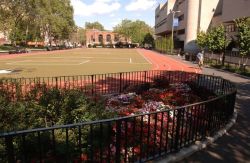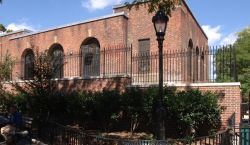Sara D. Roosevelt Park
The Daily Plant : Thursday, August 10, 2006
A Brief History Of Soccer In New York City
Games whose primary object involved kicking a ball into a goal reach back as far as 300 B.C. Modern soccer, with the no-touching-of-the-ball rule, dates back to 1815 in England and that is also where, in 1863, they created the Football Association. With the World Cup just completed, we Americans recently received our four-year reminder that the “world’s” sport is soccer, no matter what we call that big baseball contest in October.
New Yorkers pride themselves on worldliness and our City and its parks bear the names and marks of those cultures that have called New York home. By 1912, in Little Italy, Mulberry Bend Park was renamed for Columbus. Germans, who populated the Upper East Side from the late 19th through the mid-20th Century, got a park named for their national hero, Carl Schuz, and the number of parks named for people with Irish surnames is well into the dozens.
This all goes to prove that the City was by no means ignoring New York’s ethnic groups. Continuing on that line of thought, one cannot help but wonder how New York City’s parks, many of which were built during the immigrant boom of the 20th Century, weren’t brimming with soccer fields.
First of all, the existence of soccer in parks history is not completely nil. The 1916 Annual Report explains, “the popularity of soccer football in the park playgrounds is increasing each year.” They credit this in part to the Department’s “special efforts in bringing the good points of this game to the attention of our boys.” Parks organized (as it did for many sports in that era) an “Inter-Park Tournament.” Soccer was the fourth most popular sport that year after baseball, tennis, and basketball.
The Commissioners also reported that “boys of the various public, private and high schools are permitted to practice soccer and rugby football (note the careful differentiation) on the Sheep Meadow.” This fact points to one major reason why soccer never really caught on in parks: space. Even Central Park could hardly afford the space (remember the Great Lawn was still the old Reservoir). The Brooklyn Annual Reports mention the Parade Grounds in Prospect Park, as well as Dyker Park, but it is unclear which “football” they are referring to. Other large parks in the early 20th Century were too far away from populated areas, particularly ethnic neighborhoods interested in soccer. Does this mean that immigrants newly arrived from Europe did not play or see soccer? No, but if not in parks, where?
As with several recreational pastimes, including golf and swimming, this is one area where the Parks Department wasn’t always the only game in town. Soccer, perhaps more than other sports, was dependant on private associations. In fact the word derives from the “soc” of association. In the 19th Century you were either a soc-er, or if you played by the Rugby (a school in England) rules you were a rugg- er. Naturally then, the New York men (and women too!) interested in soccer formed clubs that were privately run and often sponsored by the companies for which they worked. They also often played on fields furnished by the company. The Todd (a shipbuilding company) in Brooklyn played on a field constructed in the shipyard.
As time went by and populations spread across the City, Parks saw some of the action. A 1927 New York Times clipping tells of a game that took place in McGolrick Park in Brooklyn. The headline demonstrates the importance of ethnicity to the players and fans of the day: “Centros Win, 4-2, and Keep the Lead: Beat Italians in Spanish-American Soccer League Game and Stay on Top.”
Another of the day’s games was described as follows, “The Bronx Hungarian A team of Metropolitan Worker’s League, suffered its first defeat of the season yesterday when the Freiheit Sports Club A team was the victor, 2 to 1.” Mine Gott!
These days, soccer is very prevalent in City parks. This afternoon, Parks is dedicating a newly renovated soccer field at Sara D. Roosevelt Park. To mark the occasion, players from the European Club Champion team, FC Barcelona, will be on hand. Or should we say… on foot.
Written by John Mattera
QUOTATION FOR THE DAY
“There is no sincerer love than the love of food.”
George Bernard Shaw
(1856 – 1950)
Check out your park's Vital Signs
Clean & Safe
Green & Resilient
Empowered & Engaged Users
Share your feedback or learn more about how this park is part of a
Vital Park System










